The San Francisco Giants have a pitcher that has the potential to be one of the best relievers in baseball. A pitcher with elite velocity on his fastball and nasty movement on his breaking pitch(es), yet held a 6.17 ERA, walked over 10% of batters faced and gave up fly balls on nearly half of all contact (17% HR/FB rate). 28-year-old reliever Ray Black has suffered a bit through his baseball career. Surgeries produced concerns about his elbow and shoulder which kept him from the majors longer than his contemporaries. Black has the aptitude to be an effective reliever but struggled last year. I’m going to take a look at what 2018 showed and give some analysis on what he can do to make himself a top-tier reliever in 2019.
To begin, I’ll review both his fastball and slider. I won’t really address his curveball because there really isn’t a whole lot that separates it from the behavior of his slider as you see in the overlay below. Note the movement on the breaking pitches and how the curve ends up maybe an inch or so lower than the slider.
FASTBALL
Black has an electric fastball with a mean velocity of 99 MPH and an average spin rate of 2640. The latter being good enough for fourth overall in 2018. The pitch touched 100 MPH often and has topped out at 103 MPH. Black hits the zone with his four-seamer at a league average rate of 54% and draws whiffs on about 19%. Removing zone location, Black attains 33% SwStr-rate and draws 43% fouls per swing. Let’s take a look at his fastball in action.
Black is an example of how you can’t solely rely on velocity. Despite the fact he can hit triple digits, his fastball is handled pretty well. Black allows a .286 batting average with a .289 ISO on his four-seam. The latter sees four doubles, one triple, and three home runs in 52 batted ball events. Three HRs might not seem like a lot but if you scale that to a season’s worth of plate appearances, you’re looking at as many as 30.
So how is this happening given Black’s fastball attributes? Here’s a chart of his fastball locations.
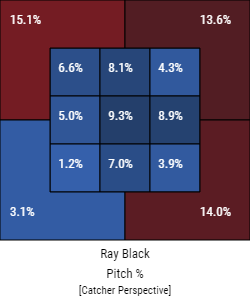
CHART 1, FB location to all hitters
He hit the middle zones quite a bit, not considering his OOZ locations. On fastballs greater than 95 MPH, the league average exit velocity is 91 MPH with a 16o launch angle. According to Baseball Savant’s Hit Probability Breakdown, those metrics will yield at least a base hit 75% of the time.
Let’s dig a bit more and look at his fastball locations versus both RHH (74% of at-bats) and LHH.
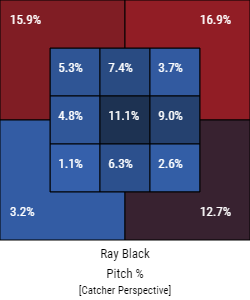
CHART 2, FB location v RHH
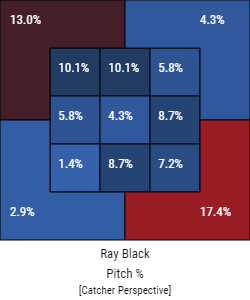
CHART 3, FB location v LHH
We know he favors the middle of the zone with his fastball and almost three out of every four batters he faces are righties, so is that where Black’s problem lies? No, actually. His BAA vs righties on his fastball is .250 (not bad, not great) but against lefties, it’s .353. That damage is done low in the zone, where most of his fastballs are concentrated against LHH. Black has at least tried to do the right thing by keeping the fastball up to lefties but he isn’t doing it enough. It’s worth mentioning that out of the 26% high fastballs, Black never yielded a hit.
Its a little bit of a different story against righties.
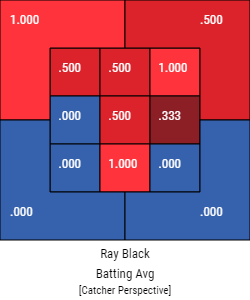
CHART 4, FB BA to RHH
As for the ‘elevate your fastball’ argument, it seems to not ring true here, even with Black’s above average velocity and spin rate. I say this because pitchers who can take advantage of Magnus Force high in the zone tend to be much more successful than pitchers who have a lowered velo and/or spin rate. The pitch creates deception by appearing to rise but it’s just an illusion- the pitch just takes much longer to drop.
However we have to consider that not only the sample size in those locations are small, but we are also without context as to what happened during those at-bats. Were they all fastballs and the hitter simply caught up? Were his breaking pitches ugly and obvious? Those questions are important because Black’s release points are not as tight as you’d like. His fastball and slider can sometimes overlap but for the most part, they are out of a different arm slot. A small difference but one nonetheless.
SLIDER
Black’s slider has all the fixings for a killer out pitch (if it isn’t already) that held the third-best spin rate in 2018 at 3091 rpm. Coupled with his mid/high-80s velocity and its spin axis, Black creates a lot of horizontal movement with some nice drop. The great thing about the pitch is that hitters are generally waiting on his fastball so when the slider comes at them, they are rarely ready for it. Take this strikeout from last summer versus the Oakland Athletics.
His numbers are pretty good on the 92 sliders he threw in 2018- .136 BAA (.167 BABIP), 47% SwStr-rate, but almost half of them fell for a ball. Now, that’s generally not a bad thing on breaking pitches but his chase rate on that pitch was well below league average. Another detriment is his home run rate per swing was basically the same as his fastball.
His curveball, which doesn’t warrant much analysis was thrown a bit less than his slider and the main problem is that either pitch can be mistaken for the other (the general consensus is the majority are sliders). Despite the fact that Pitch Info rated the curve a 2.51 wCB/C, two out of every three pitches landed out of the zone and were offered at just 25% of the time.
CONCLUSION
Black appears to want to challenge hitters with his fastball by trying to blow them away. For lesser hitters, that strategy can work. I’d like to see him keep the fastball up a lot more and try to go in on the hitter’s hands. This might be a lot to ask as Black’s control rating is a 35 (20/80). Too many of his four-seamers were left in the hitter’s wheelhouse and being a pitcher with essentially two pitches, one of which you throw a lot more, a hitter can sit on the pitch regardless of velocity. I’ve explained in the past that you need to understand the situation you’re in and be ‘liquid’ with your approach. Black hs all the confidence in his fastball and needs to believe in his slider/curveball (slurve?) more often to help him swing the count back in his favor. We know his accuracy with the breaking pitches were an issue but he can increase his chase rate if he mixes the pitches better.
Here’s something I like a lot about Black. Notice that early in counts, or when he gets behind, he’s fastball-heavy and that’s when the damage is done to him.
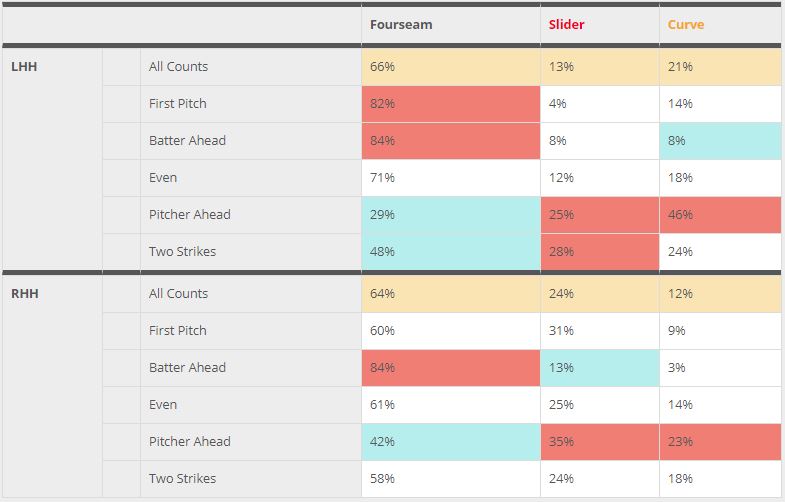
CHART 5, overall pitch usage
The bright spot is Chart 6 which shows his count trends. Notice he does well to get ahead (or at least get to an even count) and much less often falls behind. That’s important to maintain or even expand upon this year. Note in Chart 5 how when he’s ahead or with two strikes, he becomes more unpredictable (or liquid).
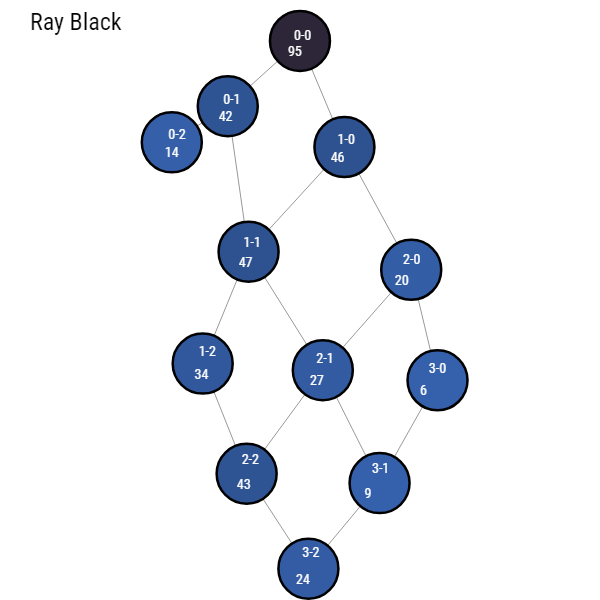
CHART 6, raw count numbers
Too often Black wanted to rely on his velocity and he doesn’t need to do that. Despite his slightly sundered release points, his fastball and slider have the movement (given proper location) to create tunnels causing hitters to have to guess a lot more. It’s so much harder to have to plan for a near-100MPH pitch than one in the lower echelon. If that slider can become more of a staple in his repertoire, hitters won’t stand a chance. Hits will become more a product of luck than skill.
The big concern will be his arm. Can Black maintain his proclivities without causing further damage? What’s good for Black is that he’s embracing pitch metrics and will hopefully better understand what he can do to take a big step forward in 2019. Should he figure it all out, the Giants will have a tremendous weapon in their bullpen this year.
(Photo by Stephen Hopson/Icon Sportswire)

Thanks for the post-Michael! I had never heard of Black before and he seems like a very intriguing pitcher.
One thing I’d note about his fastball getting teed up – it seems like he was the beneficiary of some bad luck last year. His FB exit velo of 83.8 was actually very good, as was his .291 xwOBA on the pitch.
Excited to track his progress. Gotta be pleased with this quote:
“The old school way of throwing your fastball is to throw it down, and that’s what they used to teach you, but I get hit harder when I throw the ball down than up,” he said. “I never really realized why until I looked at the spin rate. The life on my ball isn’t sinking life, the life is up in the zone, getting that secondary jump up in the zone.”
Thanks a lot, Nick!
Absolutely right. When they squared up, they almost always caused damage. Everything else was weak contact. His BABIP was pretty low as well so I didn’t really want to address luck. I think he just made some bad decisions and tended to get a little too predictable. He should be better this year given those xStats.
I loved everything the guy had to say in that article.
Very cool article! I saw Ray Black for the first time on my birthday last year when the Giant’s got trounced by the Brewers (also Johnny Cueto’s last game before TJS). They brought him in as a late reliever IIRC to give him some innings and I was really intrigued by his stuff. Cueto barely broke 90mph the whole night and Blach came in for long relief who doesn’t throw any harder, so 99+mph really stood out when Black came in. He did damage with the Slider as well which was great to see. I really think he can be everything that the Giant’s wanted out of Strickland if he can take that next step.
Is Ray back on the DL as he hasn’t pitched since April 18th